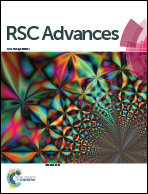CdS/CdSe co-sensitized 3D SnO2/TiO2 sea urchin-like nanotube arrays as an efficient photoanode for photoelectrochemical hydrogen generation†
Abstract
In this paper, we report a novel electrode of 3D ordered CdS/CdSe co-sensitized sea urchin-like SnO2/TiO2 nanotube arrays for photoelectrochemical hydrogen production. This novel photoanode presents excellent PEC performance, yielding a maximum photocurrent density of ∼6 mA cm−2 at 1.4 V vs. RHE under light illumination AM 1.5 (100 mW cm−2), which is due to the 3D structural effect of the SnO2/TiO2 sea urchin nanotubes, stepwise cascade band alignment between SnO2/TiO2 and CdS/CdSe as well as the improvement of light harvesting in the visible region.


 Please wait while we load your content...
Please wait while we load your content...